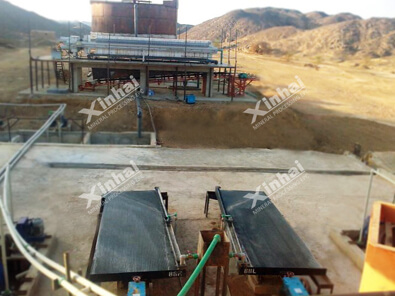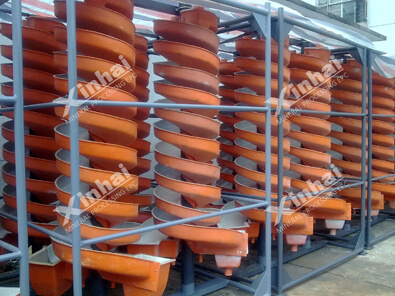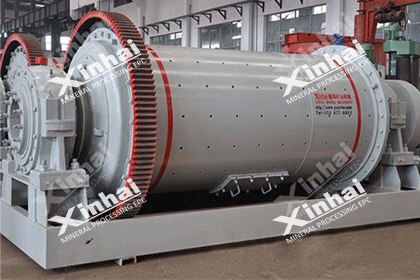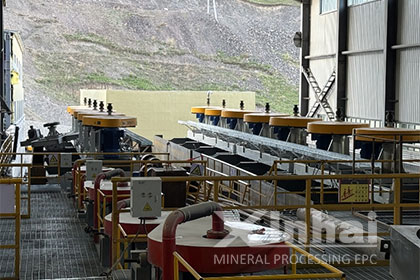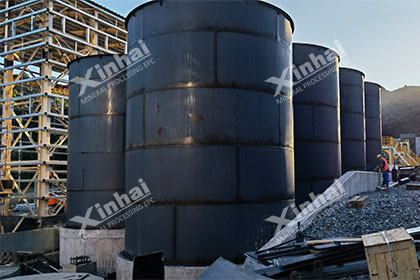What Are Flotation Methods for Polymetallic Sulfide Ore II
 Star
Star
 Sep 22, 2022
Sep 22, 2022
 1245
1245
If you want to know more details about equipment, solutions, etc, please click the button below for free consultation, or leave your requirements!
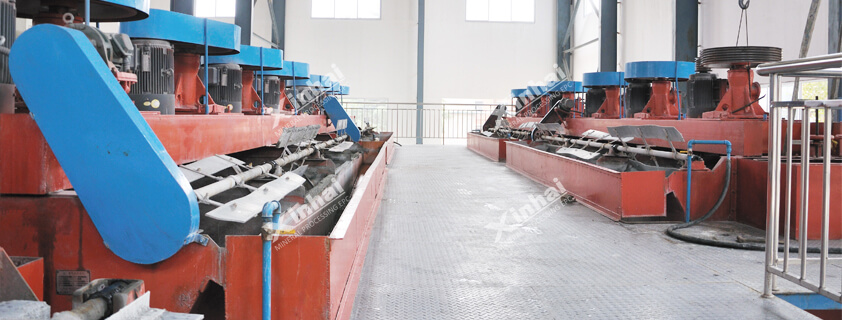
(Gold flotation plant)
Two days ago, I introduced the flotation methods of copper-lead-zinc sulfide ore, copper-lead-zinc sulfide ore, copper-molybdenum sulfide ore, copper-nickel sulfide ore, and copper-iron sulfide ore in What Are Flotation Methods for Polymetallic Sulfide Ore I. This article will continue to introduce the flotation methods of antimony-mercury sulfide ore, antimony-gold sulfide ore, tin polymetallic ore, tungsten polymetallic sulfide ore, and gold polymetallic sulfide ore. Let's drive in.
01 Antimony-mercury Polymetallic Sulfide Flotation
BackIn the antimony-mercury polymetallic sulfide ores, the main metal minerals are stibnite and cinnabar. In the beneficiation practice, there are mainly three processes to separate antimony and mercury: preferential flotation, mixed + preferential flotation, and mineral processing-metallurgical combination. Because the floatability of cinnabar is better than that of stibnite, and the mercury content in antimony-mercury polymetallic sulfide ore is relatively low, generally 0.1%-0.5%, the antimony suppression mercury float method is usually used.
(1) Antimony-mercury priority flotation
Sodium sulfide method is commonly used in antimony mercury flotation. Specific steps are as follows:
Step1 Add sodium sulfide to the pulp, adjust the pH value to alkaline to inhibit the activity of stibnite;
Step2 Use a collector with better selectivity to preferentially flotation cinnabar;
Step3 Add the activator copper sulfate to the flotation tailings to flotate the stibnite to separate the antimony and mercury.
(2) Antimony-mercury mixing + priority flotation
First, the mixed flotation is carried out to obtain the antimony-mercury mixed concentrate, and then the preferential flotation is carried out, cinnabar is selected pirior to antimony. Specific steps are as follows:
Step1 Using copper sulfate as the activator, adding collectors and foaming agents, mixing and flotation of antimony mercury sulfide minerals
Step2 Carry out flotation separation of antimony-mercury mixed concentrate. The stibnite is inhibited by the heavy phenate method, and the cinnabar is preferentially flotated.
The practice in the flotation process of antimony mercury sulfide minerals proves that the beneficiation index of this method is better.
(3) Antimony-mercury beneficiation + smelting
Antimony-mercury sulfide minerals are embedded with fine particle size and complex symbiotic relationship. It is difficult to separate antimony and mercury by general beneficiation methods. Therefore, the combined process of antimony and mercury beneficiation and smelting can be used. Specific steps are as follows:
Step1 Mixed flotation to obtain antimony-mercury mixed concentrate (generally less than 3% mercury)
Step2 The mixed concentrate is fed into the shrinking furnace, and the metal mercury is extracted by vacuum method, and the rest remains in the slag
Step3 Reverberatory furnace is used to extract metal antimony to separate antimony and mercury.
02 Antimony-gold Polymetallic Sulfide Flotation
BackIn the antimony-gold sulfide ore, stibnite, natural gold, pyrite and arsenopyrite are four main minerals, and gold often exists in pyrite and arsenopyrite. Arsenopyrite usually contains arsenic, and sometimes pyrite also contains arsenic. Therefore, antimony gold polymetallic sulfide minerals contain high arsenic. During beneficiation, except for the recovery of coarse-grained natural gold by gravity separation, most of them are the separation of stibnite, pyrite, arsenopyrite and other minerals. In practice, there are preferential flotation and mixed-preferential flotation in the process of flotation separation of antimony and gold minerals. There are four commonly used flotation separation methods.
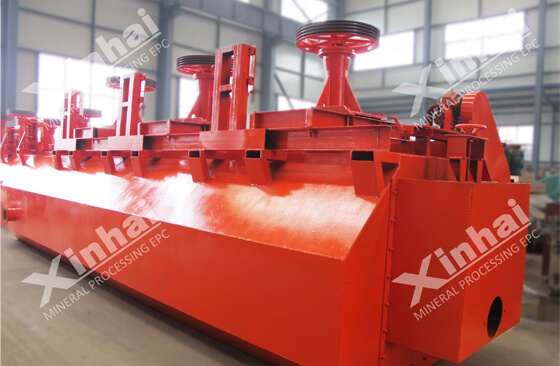
(Flotation cell for polymetal ore separation)
(1) Antimony-gold preferential flotation (sodium hydroxide method)
The priority flotation process is adopted, gold is flotated prior to antimony. The specific process is as follows:
Step1 Add sodium hydroxide to the ball mill and grind the ore in the strong alkaline slurry to inhibit the activity of stibnite;
Step2 Use copper sulfate as an activator to activate arsenopyrite and pyrite;
Step3 Adjust the pulp to weak alkaline, add collector and foaming agent, flotate pyrite and arsenopyrite to obtain gold concentrate.
Step4 Add lead salt to the flotation tailings to activate the stibnite, and then add collectors and frothers for flotation to obtain antimony concentrate.
(2) Antimony-gold mixing-preferential flotation (sodium sulfide-sodium hydroxide method)
The mixed-priority flotation process is adopted, and the mixed concentrate of antimony and gold is selected first, then flotate gold prior to antimony. The specific process is as follows:
Step1 Add sodium hydroxide and sodium carbonate to inhibit the activity of stibnite during the grinding process
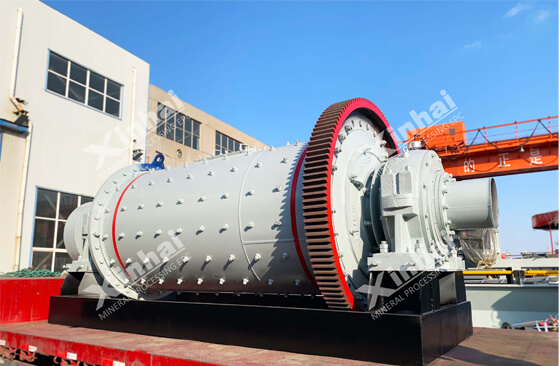
(Ball mill)
Step2 Add zirconium acetate, copper sulfate, butyl xanthate and sulfuric acid for mixed flotation to obtain antimony-gold mixed concentrate and waste tailings.
Step3 Antimony-gold mixed concentrate regrinding
Step4 Add sodium hydroxide, butyl xanthate and copper sulfate to the pulp and inflate it for a few minutes, then carry out flotation separation to obtain gold coarse concentrate, and the product in the tank is antimony concentrate.
Step5 Add sodium sulfide and sodium hydroxide to the gold coarse concentrate slurry to inhibit the activity of stibnite, and obtain gold concentrate and low-grade antimony concentrate.
(3) Antimony-gold mixed flotation (oxidant method)
Before flotation separation of antimony-gold mixed concentrate, add oxidant bleaching powder or potassium permanganate (pulp solid: liquid = 1:3) and stir for 1 minute to oxidize the surface of mineral particles. Then add 100 g/ton of lead acetate, and use xanthate as a collector to flotate stibnite.
(4) Antimony-gold priority flotation(butylammonium black medicine method)
Butyl ammonium black medicine has a strong ability to collect antimony, but a weaker ability to collect arsenopyrite and pyrite, so it can effectively separate antimony and gold by flotation. The specific process is as follows:
Step1 First, select coarse-grained monomer native gold by gravity in the grinding-classifying circuit.
Step2 Using the priority flotation process, adding sulfuric acid to the pulp to obtain a weakly acidic environment, using lead salt as the activator, butylammonium black medicine as the collector, terpineol oil as the foaming agent, and preferentially selecting stibnite to obtain antimony concentrate mine.
Step3 Flotation tailings are coarse concentrates containing gold arsenopyrite. Add xanthate and frother to flotation tailings to flotate gold-containing arsenopyrite concentrate, and extract gold from it.
Step4 Antimony concentrate also contains a small amount of gold, which can be recovered in the process of smelting antimony.
03 Tin-bearing Polymetallic Sulfide Flotation
BackThe tin-containing polymetallic sulfide ore has a complex mineral structure. Cassiterite is closely symbiotic with various sulfide minerals, and useful minerals are not easy to dissociate individually. Some minerals and cassiterite not only have a small difference in specific gravity, but also have a finely embedded particle size. Therefore, it is difficult to achieve effective separation of useful minerals by single gravity separation, and a combined process of beneficiation must be used. There are mainly four methods: gravity separation-flotation, gravity separation-flotation-gravity separation, flotation-gravity separation, flotation-gravity separation-magnetic separation.
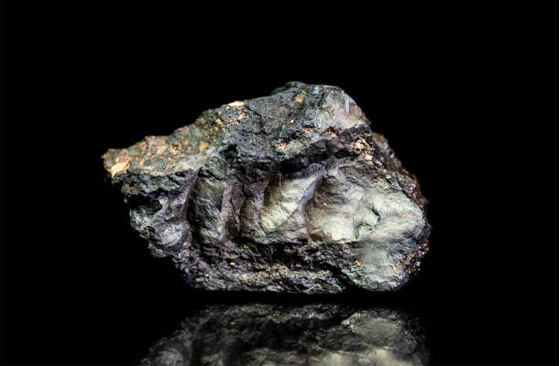
(1) Gravity-flotation
Gravity-flotation process is suitable for minerals containing pyrrhotite generally less than 10%, cassiterite and various metal sulfide minerals with extremely complex symbiotic relationship, fine-grained, mostly finely crystalline and dispersed minerals. Specific steps are as follows:
Step1 After the raw ore is ground, first use jigging or shaking table to select the mixed concentrate of tin-containing polymetallic sulfide minerals, and discard the tailings.
Step2 Then regrind the mixed coarse concentrate to float the mixed concentrate of sulfide minerals
Step3 Then carry out flotation separation, and the tailings are tin concentrate
(2) Gravity -flotation-gravity
Gravity-flotation-gravity separation process is suitable for ore containing pyrrhotite generally less than 10%, the symbiotic relationship between cassiterite and various metal sulfide minerals is complex, and useful minerals are mainly in the form of fine grains in ores with uneven distribution of coarse and fine grains. Specific steps are as follows:
Step1 The crude ore is first processed by gravity to obtain a mixed coarse concentrate containing cassiterite-sulfide minerals, and most of the tailings are discarded.
Step2 The mixed coarse concentrate is finely ground and flotated to obtain a mixed concentrate of sulfide minerals.
Step3 The flotation tailings are processed by gravity to obtain high-grade tin concentrate, and part of the tailings are discarded.
(3) Flotation-Gravity separation
The flotation-gravity process is suitable for ore concentrators whose main purpose is to recover tin. When the tin content of the original ore is more than 0.5%, the content of pyrrhotite is relatively high, generally more than 10%, and the tin ore and the metal sulfide minerals in the ore are unevenly embedded in fine grains and closely symbiotic, and this kind of process is mostly used. Specific steps are as follows:
Step1 After the ore is ground and classified, the mixed concentrate is first obtained by mixed flotation.
Step2 The flotation tailings are processed by gravity to obtain tin concentrate and part of the tailings are discarded.
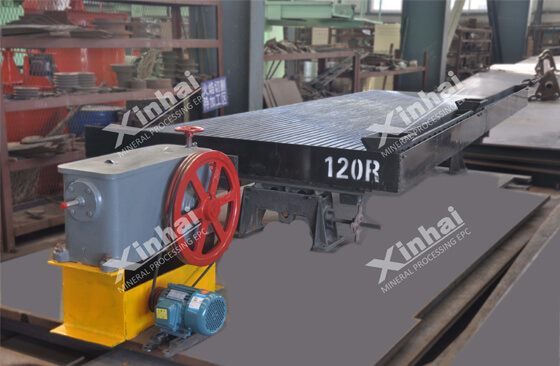
(Shaking table)
(4) Flotation-gravity-magnetic separation
This process is suitable for ore containing tin below 0.5%, polymetallic sulfides and non-sulfide minerals with high specific gravity, and pyrrhotite below 10%, all kinds of minerals are closely symbiotic, and the embedded particle size is uneven. of complex minerals.
04 Tungsten-bearing Polymetallic Sulfide Flotation
BackWhen the tungsten-containing polymetallic sulfide ores are sorted, the combined process of gravity separation-flotation is mainly used. When there are many symbiotic magnetic minerals in the ore, a magnetic separation process will also be added. The principle processes for handling this type of ore are as follows:
(1) Gravity-flotation process
It is mainly used for tungsten-containing polymetallic sulfide ore with high tungsten-containing grade, coarse inlaid particle size and simple mineral composition. Specific steps are as follows:
Step1 The ore is directly processed by gravity after rough grinding, and the sulfide minerals are selected into the tungsten rent concentrate
Step2 Then use shaking table flotation to obtain tungsten concentrate and mixed sulfide mineral concentrate
Step3 The mixed sulfide mineral concentrate is separated by flotation.
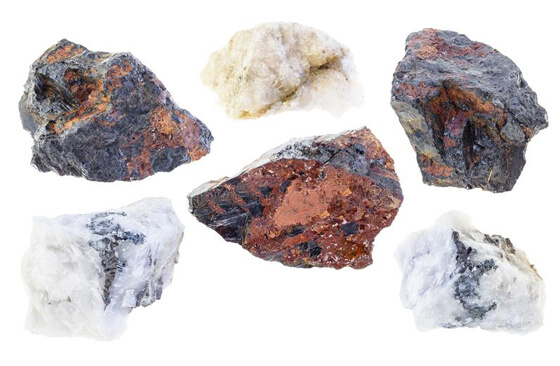
(Different types of tungsten ore)
(2) Flotation-gravity separation process
It is suitable for tungsten minerals and sulfide minerals that are embedded in fine grains and have complex tungsten-containing polymetallic sulfide minerals. Specific steps are as follows:
Step1 Grind the ore to the particle size required for flotation, and then mix the flotation first to obtain a mixed concentrate of sulfide minerals
Step2 The mixed concentrate is separated by flotation to obtain various sulfide mineral concentrates
Step3 The tailings of mixed flotation are processed by gravity to obtain tungsten concentrate.
If the ore is scheelite, it is recovered by flotation from the flotation tailings. Especially for ores with less tungsten and more sulfide minerals, first consider flotation of sulfide minerals and then recover tungsten from the tailings by gravity separation or flotation. You can read more here about wolframite and scheelite mineral processing technology.
(3) Gravity-flotation-gravity sepatation process
When wolframite and sulfide minerals are embedded in gangue in aggregate, the gravity separation-flotation-gravity separation process is suitable. Specific steps are as follows:
Step1 First use the rough grinding-gravity separation process to obtain the tungsten-sulfur rough concentrate
Step2 Then use the regrinding-mixed flotation process to obtain a tungsten-sulfur mixed concentrate
Step3 Then the mixed concentrate is separated by flotation to obtain a single concentrate
Step4 Finally, the mixed flotation tailings are recovered by gravity separation method to recover wolframite.
(4) Magnetic separation-gravity-flotation process
Magnetic separation-gravity separation-flotation process is suitable for tungsten-containing polymetallic sulfide ores containing a large amount of magnetic minerals. Specific steps are as follows:
Step1 First, use magnetic separation to select magnetic minerals to reduce the interference of magnetic minerals on gravity flotation.
Step2 Then separate other minerals by the combined process of gravity and flotation
In a word, if the output value of tungsten is large, tungsten minerals are the main object to be recovered first in beneficiation; the recovery of associated sulfide minerals is a secondary product. In order to maximize the comprehensive recovery of tungsten minerals and their associated useful minerals in this type of ore, it is difficult to obtain better results with a single and simple beneficiation process. Therefore, if the ore is mainly wolframite, the beneficiation method used is mainly gravity separation, combined with the technological process of various beneficiation methods. If the ore is mainly scheelite, flotation is the main method to recover various useful minerals.
05 Gold-bearing Polymetallic Sulfide Flotation
BackIn the gold-bearing polymetallic sulfide ores, the grade of gold is relatively high, generally above 3g/t. Therefore, the beneficiation process must focus on gold recovery and comprehensive recovery of other metal sulfide minerals. Gold-bearing polymetallic sulfide ore is mainly divided into gold-bearing copper-sulfur ore, gold-bearing copper-aluminum-zinc ore, antimony-gold ore, and antimony-tungsten-gold ore. The main associated minerals are chalcopyrite and pyrite.
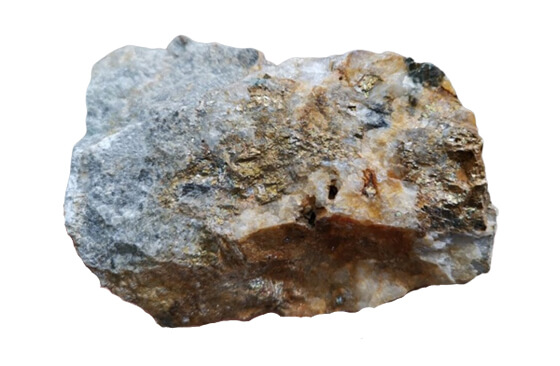
(Gold-bearing polymetallic sulfide ore)
(1) Gold-copper sulfide ore preferential or mixed flotation
There are many sulfide ores coexisting with gold and copper. In this type of ores, gold mainly occurs in chalcopyrite and pyrite, and exists in fine particles. Therefore, gold-copper sulfide ore beneficiation often adopts priority or mixed flotation process. By adding lime to the pulp to inhibit pyrite, preferentially flotation of copper sulfide minerals, and finally obtain qualified gold-bearing copper sulfide concentrate.
(2) Gold-copper-lead-zinc sulfide mixed flotation
When processing gold-copper-lead-zinc polymetallic sulfide ore, a partial mixed flotation process is often used, first selecting copper-lead mixed concentrate, and then flotation separation of the mixed concentrate to obtain lead concentrate and gold-bearing copper concentrate .
(3) Antimony-gold priority or mixed flotation
We have talked about this on the second part in this article.
(4) Gold-copper-iron flotation-magnetic separation
The main minerals in gold-copper-iron polymetallic sulfide ore are magnetite and chalcopyrite. Natural gold occurs in chalcopyrite as fine particles. The combined flotation-magnetic separation process can effectively separate gold-copper and iron, and finally get gold-copper mixed concentrate and iron concentrate.
06To Wrap Up
BackThe above is an introduction to the flotation methods of antimony mercury sulfide ore, antimony gold sulfide ore, tin polymetallic ore, tungsten polymetallic sulfide ore, and gold polymetallic sulfide ore.
If you want to carry out a polymetallic sulfide ore beneficiation project, you can consult us, and we will provide you with a suitable beneficiation solution.
 +86 182 3440 3483
+86 182 3440 3483 yanzhang19990421@gmail.com
yanzhang19990421@gmail.com




 Message
Message Chat Now
Chat Now


